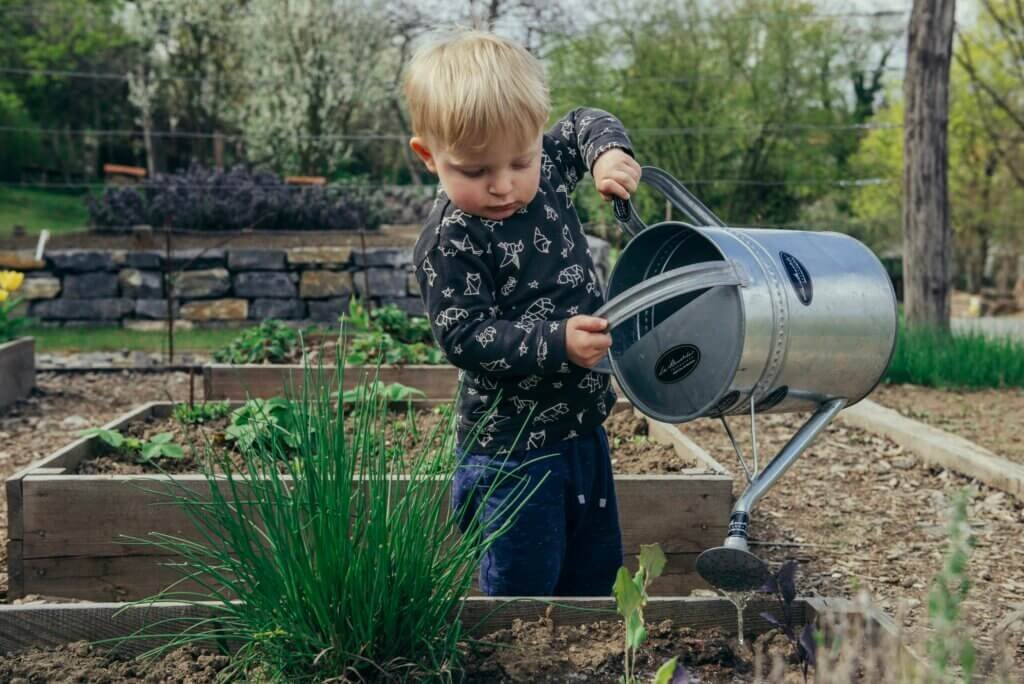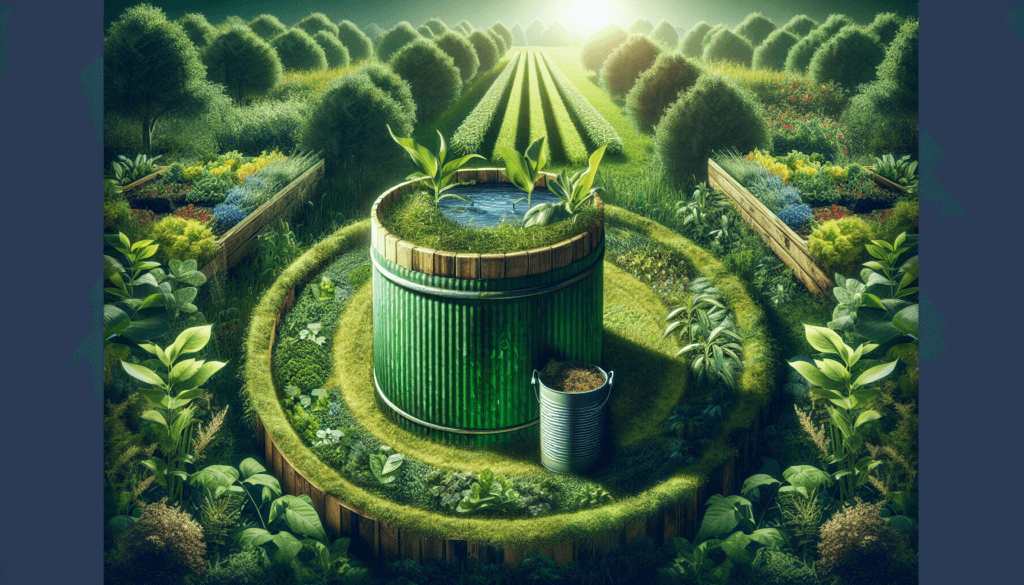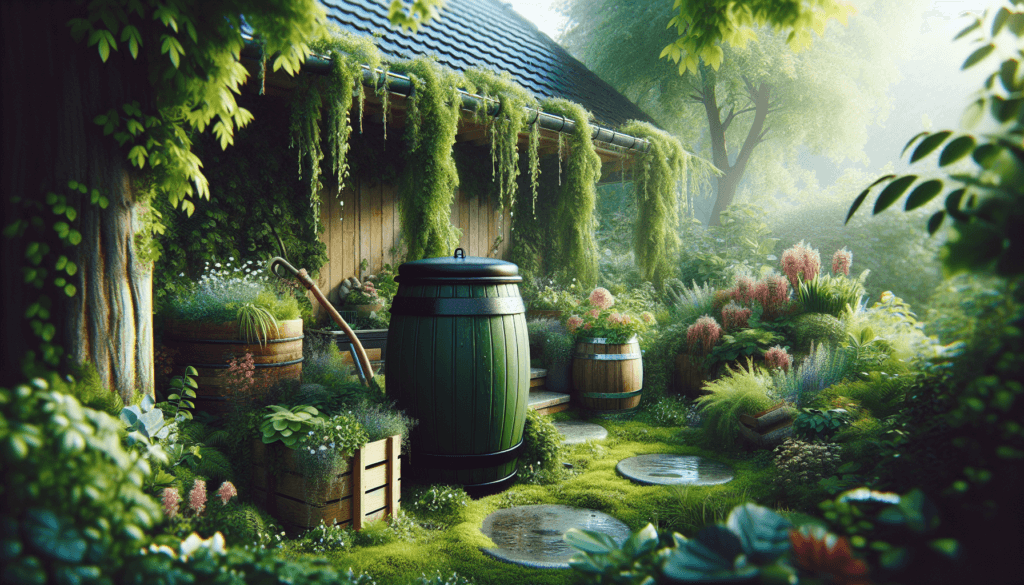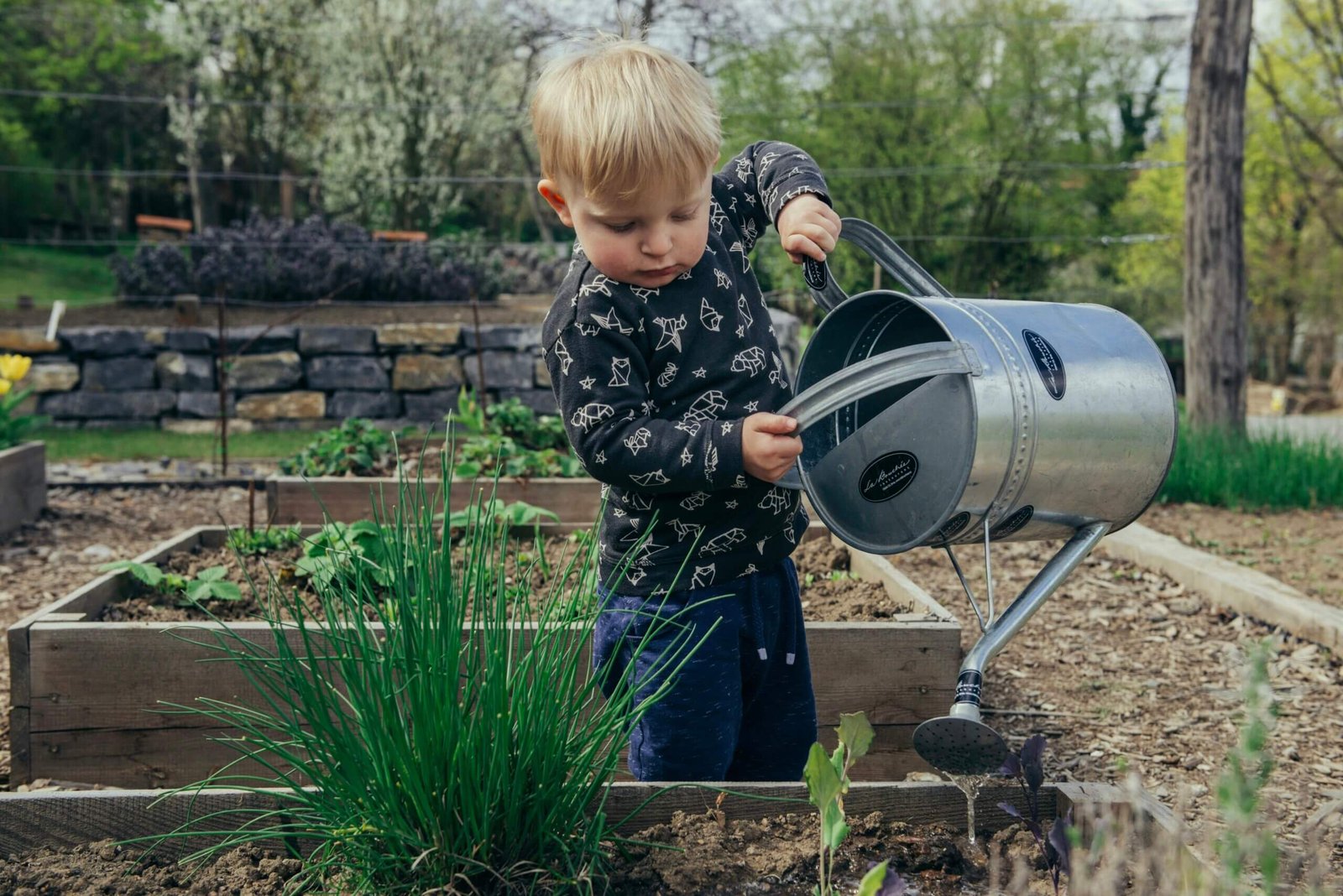Are you a beginner gardener looking to start your own eco-friendly garden? Look no further! In this article, you will discover the top techniques that will not only help you create a beautiful garden, but also take care of the environment. From composting to companion planting, we will guide you through the step-by-step process of implementing these techniques, ensuring that you have a thriving garden while minimizing your impact on the planet. So grab your gardening tools and let’s get started on this green journey!
Water Conservation
Collect rainwater
One of the easiest and most effective ways to conserve water in your garden is to collect rainwater. Installing a rain barrel or a larger rainwater harvesting system allows you to collect and store rainwater that can then be used to water your plants. This not only helps to reduce your water bill, but it also helps to conserve water resources and reduce the strain on municipal water supplies.
Use a drip irrigation system
Drip irrigation is a highly efficient watering technique that delivers water directly to the roots of plants. Unlike traditional sprinkler systems that often waste water through evaporation or runoff, drip irrigation ensures that water is delivered where it is needed most. By using a drip irrigation system, you can significantly reduce water wastage and promote healthier, more drought-resistant plants.
Mulch your garden
Mulching is a simple yet effective technique that helps to conserve water in your garden. By spreading a layer of organic mulch, such as wood chips or straw, around your plants, you can help to retain soil moisture and reduce water loss through evaporation. Additionally, mulch also helps to suppress weed growth and regulate soil temperature, promoting a healthier and more productive garden.
Reuse household water
Another great way to conserve water in the garden is by reusing household water. Instead of letting clean water from activities such as washing dishes or cooking go down the drain, consider collecting it in a bucket or basin. This “greywater” can then be used to water your plants, reducing the need for additional freshwater. Just make sure to avoid using greywater that contains harsh chemicals or soaps that can harm your plants.
Composting
Start a compost pile
Composting is a fantastic way to reduce waste and improve the health of your garden. By starting a compost pile, you can turn kitchen scraps, yard waste, and other organic materials into nutrient-rich compost that can be used to feed your plants. Composting not only helps to reduce the amount of waste going to landfills but also enhances soil fertility, aids in moisture retention, and promotes healthy plant growth.
Use kitchen scraps
When it comes to composting, kitchen scraps are an excellent source of organic material. Items such as fruit and vegetable peels, coffee grounds, and eggshells can all be added to your compost pile. However, it’s important to avoid including meat, dairy, or oily foods, as these can attract pests and slow down the decomposition process. By diverting kitchen scraps from the trash bin and putting them to good use in your compost pile, you can contribute to a more sustainable gardening practice.
Add yard waste
In addition to kitchen scraps, yard waste such as grass clippings, leaves, and small branches can also be added to your compost pile. These materials are rich in carbon, which helps to balance the nitrogen content of your compost. To speed up the decomposition process, be sure to chop or shred larger pieces of yard waste before adding them to the pile. Remember, the key to successful composting is a good balance of carbon-rich “browns” and nitrogen-rich “greens.”
Turn the compost regularly
To ensure that your compost decomposes properly and quickly, it’s essential to turn the pile regularly. This helps to aerate the compost, allowing oxygen to reach the microorganisms responsible for breaking down the organic material. Turning the compost also helps to distribute moisture evenly and prevents the formation of anaerobic conditions, which can lead to unpleasant odors. Aim to turn your compost pile at least once a week, or more frequently if you notice that the pile is not heating up or breaking down efficiently.

Natural Pest Control
Attract beneficial insects
When it comes to pest control, nature can be your best ally. Many beneficial insects, such as ladybugs, lacewings, and bees, play a vital role in keeping garden pests in check. To attract these helpful creatures to your garden, include plants that provide nectar, pollen, or shelter. Marigolds, sunflowers, and lavender are just a few examples of plants that are known to attract beneficial insects. By creating a welcoming habitat for these natural predators, you can reduce your reliance on chemical pesticides and promote a healthier, more balanced ecosystem in your garden.
Introduce natural predators
Sometimes, even with the best preventative measures, pests can still find their way into your garden. Instead of resorting to harmful chemicals, consider introducing natural predators to deal with the problem. For example, ladybugs can help control aphids, while praying mantises feast on a variety of garden pests. You can attract these predators to your garden by purchasing and releasing them or by creating suitable habitats such as bug hotels or nesting boxes. By letting nature take its course and allowing these predators to do their job, you can effectively manage pest populations in an eco-friendly way.
Use companion planting
Companion planting is a technique that involves growing certain plants together to benefit each other in various ways, including pest control. Some plants have natural repellent properties that can deter pests from damaging other plants. For example, planting marigolds alongside tomatoes can help deter nematodes, while planting aromatic herbs like basil, rosemary, or mint near cabbage can help repel pests like cabbage worms. By strategically arranging your garden to include compatible plant combinations, you can help protect your plants from pests naturally.
Make your own organic insecticides
If pests become too numerous or problematic, making your own organic insecticides can be a more sustainable option than resorting to synthetic chemical sprays. Common ingredients such as neem oil, garlic, peppermint oil, or soap solutions can be mixed with water and applied to affected plants. These homemade insecticides are typically less harmful to beneficial insects and wildlife while still effectively controlling pests. Remember to use them sparingly and target only the affected areas to minimize potential risks.
Organic Fertilizers
Use compost as fertilizer
In addition to being a valuable soil amendment, compost can also serve as an excellent organic fertilizer. By enriching your soil with nutrient-rich compost, you provide essential elements for plant growth and help improve soil structure. Compost slowly releases nutrients over time, reducing the risk of nutrient runoff and leaching. It also promotes the growth of beneficial soil microbes, which further enhance nutrient availability and plant health. Whether incorporated into the soil or used as a top dressing, compost is a sustainable and cost-effective way to feed your garden.
Utilize organic alternatives
When it comes to fertilizing your garden, there are numerous organic alternatives available that can provide the essential nutrients your plants need. Organic fertilizers, such as fish emulsion, seaweed extract, bone meal, or blood meal, are derived from natural sources and contain a variety of nutrients in balanced proportions. These products are often slow-releasing, ensuring a steady supply of nutrients to your plants without the risk of burning or harming them. Look for organic fertilizers labeled as “OMRI Listed” to ensure they meet organic standards and have been reviewed for use in organic production.
Apply natural amendments
In addition to traditional organic fertilizers, natural amendments can also help improve the fertility of your soil. Materials such as rock dust, kelp meal, and green manure crops add trace minerals, organic matter, and nitrogen to the soil, respectively. These amendments help replenish depleted nutrients, enhance soil structure, and promote healthy root growth. By incorporating natural amendments into your soil, you can create a nutrient-rich environment that supports your plants’ growth and overall garden vitality.
Avoid synthetic fertilizers
Synthetic fertilizers are manufactured from non-renewable resources and often contain high levels of salts and chemicals that can be harmful to the environment. By avoiding their use and opting for organic fertilizers and amendments instead, you can limit your garden’s nutrient inputs and reduce the risk of water contamination. Organic practices promote a more sustainable and balanced approach to fertilization, ensuring the long-term health and productivity of your garden while minimizing negative environmental impacts.

Native Plants
Choose native species
When planning your garden, consider incorporating native plant species whenever possible. Native plants are adapted to the local climate and soil conditions, making them more likely to thrive and require less maintenance. They have evolved alongside local wildlife and provide essential food and habitat resources for native insects, birds, and other animals. By choosing native plants, you can create a biodiversity-rich garden that supports local ecosystems and contributes to the conservation of native species.
Plant for biodiversity
Promoting biodiversity in your garden is not only beneficial for the environment but also for your plants’ health and resilience. By planting a variety of different species, you create a diverse ecosystem that supports a wide range of beneficial organisms and reduces the risks of pest outbreaks and diseases. Incorporate plants with different flowering times and structures to provide a continuous food source for pollinators and other wildlife throughout the year. A biodiverse garden is not only visually appealing but also more sustainable and capable of withstanding environmental challenges.
Support local wildlife
By creating a garden that provides food, shelter, and water sources, you can attract a variety of wildlife species to your backyard. Native plants are particularly valuable in this regard, as they offer the necessary resources for local insects, birds, and other animals. Consider planting trees and shrubs that produce berries or fruits, installing bird feeders or nesting boxes, and providing water features or birdbaths. By supporting local wildlife, you contribute to the overall balance and resilience of your garden ecosystem.
Reduce water and chemical use
Native plants are well adapted to local environmental conditions, which often means they require less water and chemical inputs. By incorporating native species into your garden, you can reduce your water consumption and the need for synthetic pesticides or fertilizers. Native plants have evolved to withstand local pests and diseases, and their deep root systems help them access water deep in the soil. By choosing natives, you can create a low-maintenance garden that conserves resources and supports a healthier and more sustainable environment.
Crop Rotation
Rotate crops annually
Crop rotation is a technique that involves planting different crops in different areas of your garden each year. By rotating your crops annually, you disrupt pest and disease cycles, prevent soil depletion, and promote overall garden health. Different plant families have different nutrient requirements and attract different pests and diseases. By moving crops to different locations annually, you help break these cycles and reduce the likelihood of recurring problems. A well-planned crop rotation can lead to higher yields and healthier plants.
Prevent soil depletion
Planting the same crops in the same location year after year can deplete the soil of specific nutrients and increase pest and disease pressures. By rotating your crops, you give the soil a chance to replenish nutrients naturally and avoid the buildup of pests and diseases. Plants in different families have different nutritional needs and contribute or take up specific nutrients from the soil. By rotating crops, you balance these nutrient demands and ensure that the soil remains fertile and healthy.
Control pests and diseases
Certain pests and diseases have a specific host range and are more likely to thrive if their preferred host plants are consistently present in the same location. By rotating crops, you disrupt their life cycles and make it more difficult for them to survive. For example, pests that target tomatoes may struggle to find suitable hosts if tomatoes are not grown in the same spot every year. Similarly, diseases that survive in the soil may die off if their preferred host plants are not continuously present. Crop rotation is a valuable tool in organic pest and disease management.
Improve overall soil health
Healthy soil is the foundation of a successful garden. Crop rotation helps improve soil health by reducing nutrient imbalances, promoting beneficial soil microbes, and maintaining organic matter levels. Different crops have different root structures and exude different substances into the soil, which can help break up compacted soil, improve its structure, and enhance its water-holding capacity. By practicing crop rotation, you contribute to the long-term health and fertility of your soil, ensuring that it remains productive and able to support healthy plant growth.

Weed Management
Mulch to suppress weeds
One of the most effective ways to manage weeds in your garden is by using mulch. By applying a layer of organic mulch, such as wood chips, straw, or shredded leaves, you can smother weed growth and prevent weed seeds from germinating. Mulch not only blocks sunlight from reaching weed seeds but also helps to retain soil moisture and regulate soil temperature. Additionally, as the mulch breaks down, it contributes organic matter to the soil, improving its fertility and overall health.
Hand-pull weeds
For existing weeds that manage to poke through the mulch, hand-pulling is an effective and eco-friendly way to manage them. Make sure to remove the entire weed, including the roots, to prevent regrowth. It’s best to pull weeds when the soil is moist, as they are easier to uproot. Regularly inspect your garden for weeds and remove them as soon as possible. By staying vigilant and consistently hand-pulling weeds, you can prevent them from setting seeds and spreading throughout your garden.
Use vinegar as a weed killer
If you’re dealing with persistent or stubborn weeds, vinegar can be used as a natural weed killer. Household vinegar with an acetic acid concentration of 5% or higher can be sprayed directly onto the weeds, killing them effectively. However, it’s important to be cautious when using vinegar, as it can also harm desirable plants and soil microorganisms if used excessively or in concentrated form. To minimize risks, apply vinegar carefully, targeting only the weeds and avoiding contact with surrounding plants or soil.
Try natural weed control methods
In addition to mulching, hand-pulling, and vinegar, there are other natural weed control methods you can try in your garden. Boiling water can be poured directly onto weeds to scald and kill them, but be cautious as this can also harm nearby plants. You can also use a flame weeder, which uses heat to kill weeds by burning them. Just be careful and use appropriate safety precautions when working with open flames. Additionally, regular cultivation and hoeing can disrupt weed growth and prevent them from establishing.
Integrated Pest Management
Identify pests accurately
In order to effectively manage pests in your garden, it’s important to accurately identify them. Different pests require different control strategies, and misidentifying a pest can lead to ineffective or unnecessary treatments. Take the time to research and learn about common garden pests in your area, and familiarize yourself with their characteristics and life cycles. By correctly identifying pests, you can choose the most appropriate control methods and minimize damage to your plants and the environment.
Monitor pest populations
Regularly monitoring the pest populations in your garden can help you stay ahead of potential problems and take early action if necessary. Regularly inspect your plants and look for signs of pest activity, such as chewed leaves, holes, or discoloration. Use sticky traps, pheromone traps, or visual inspections to assess pest populations. By monitoring pest populations, you can detect problems early on, making control efforts more effective and reducing the need for more drastic measures.
Use biological controls
Biological controls involve the use of beneficial organisms to manage pest populations naturally. Ladybugs, lacewings, nematodes, and predatory mites are examples of beneficial insects that can be introduced to your garden to control pest populations. These natural predators feed on garden pests such as aphids, spider mites, or caterpillars. Before introducing beneficial organisms, make sure they are appropriate for the pest problem you are facing and that you provide a suitable environment for their survival. Biological controls are a sustainable and environmentally friendly approach to pest management.
Implement preventive measures
Prevention is key when it comes to integrated pest management. By implementing preventive measures, you can reduce the likelihood of pest infestations and the need for control methods. Some preventive measures include choosing pest-resistant plant varieties, maintaining plant health through proper watering and fertilization, practicing good garden hygiene by removing debris and fallen leaves, and using physical barriers such as row covers or netting. By creating an environment that is unfavorable for pests and promoting plant health, you can greatly reduce the need for chemical interventions.

Pollinator-friendly Gardens
Plant flowers for pollinators
Pollinators, such as bees, butterflies, and hummingbirds, play a crucial role in the pollination of many plants. By planting a variety of flowers that provide nectar and pollen, you can attract and support these important pollinators in your garden. Choose flowers of different shapes, colors, and bloom times to provide a continuous food source throughout the year. Native plants are particularly valuable, as they have evolved alongside native pollinators and are perfectly suited to their needs.
Provide water sources
Pollinators also need access to water for drinking and cooling purposes. By providing water sources in your garden, you can create a pollinator-friendly environment. Shallow dishes or birdbaths filled with clean water can serve as drinking stations for bees and butterflies. Adding small rocks or pebbles to the water sources can also provide perching spots for butterflies and other insects. Regularly refill the water and clean the containers to ensure a fresh and safe water supply for pollinators.
Avoid pesticide use
Pesticides, especially insecticides, can harm pollinators and disrupt the delicate balance of your garden ecosystem. Whenever possible, avoid using pesticides and opt for natural pest control methods instead. If the use of pesticides is necessary, carefully read and follow the label instructions to minimize risks to pollinators. Apply pesticides in the late evening or early morning when pollinators are less active, and avoid applying them to flowering plants to avoid direct exposure.
Create habitat and nesting areas
In addition to food and water, pollinators also need suitable habitat and nesting areas. Incorporate native shrubs, trees, and grasses into your garden to provide shelter, nesting sites, and overwintering habitats for pollinators. Dead branches, hollow stems, or small piles of leaves can provide suitable nesting spots for certain pollinators, such as solitary bees. By creating a diverse and welcoming environment that meets all the needs of pollinators, you can contribute to their conservation and support their vital role in plant reproduction.
Sustainable Garden Design
Choose low-maintenance plants
When designing your garden, consider choosing low-maintenance plants that require less water, pruning, or fertilization. Native plants are often well adapted to local conditions and require minimal care once established. Look for plant varieties that are disease-resistant and drought-tolerant, reducing the need for interventions and promoting a more sustainable garden. By choosing low-maintenance plants, you can spend less time and effort on garden chores and enjoy a more sustainable and enjoyable outdoor space.
Design for efficient water use
Water is a precious resource, and designing your garden with efficient water use in mind helps to conserve this valuable commodity. Grouping plants with similar water needs together and using a drip irrigation system ensures that water is delivered directly to the roots of plants, minimizing wastage. Incorporating rainwater harvesting systems allows you to take advantage of natural rainfall and reduce reliance on municipal water supplies. By implementing efficient water practices, you can create a water-wise garden that thrives while minimizing water waste.
Use permeable hardscapes
Permeable hardscapes, such as gravel paths or permeable pavers, help to reduce stormwater runoff and prevent erosion. Unlike traditional hard surfaces, which can contribute to water runoff and pollution, permeable surfaces allow water to infiltrate into the soil. This reduces the strain on storm drains and prevents contaminants from being carried into local waterways. By incorporating permeable hardscapes into your garden design, you can minimize your environmental footprint and contribute to a healthier watershed.
Incorporate sustainable materials
When designing or redesigning your garden, consider incorporating sustainable materials into the hardscape and structures. Recycled or repurposed materials, such as reclaimed wood or recycled plastic, can be used for raised beds, trellises, or garden borders. These materials not only reduce waste but also promote a more sustainable and eco-friendly garden. Additionally, choose natural and non-toxic finishes or paints when using these materials to minimize any potential environmental impacts.
In conclusion, eco-friendly gardening practices are not only good for the environment but also beneficial for your garden’s health and productivity. By implementing water conservation techniques like collecting rainwater and using drip irrigation, you can reduce water waste and ensure your plants receive the necessary moisture. Composting kitchen scraps and yard waste allows you to recycle organic material into nutrient-rich compost, improving soil fertility and reducing waste. Natural pest control methods like attracting beneficial insects and using companion planting can help manage pests without harmful chemicals. Utilizing organic fertilizers, planting native species, and implementing crop rotation techniques further promote sustainable gardening practices. By practicing weed management, integrated pest management, and creating pollinator-friendly gardens, you can create a healthy and vibrant ecosystem in your garden. Lastly, incorporating sustainable materials and designing for efficient water use helps to reduce your environmental impact while creating a beautiful and sustainable garden space. With these top eco-friendly gardening techniques, beginners can embark on a rewarding journey towards a more sustainable and environmentally conscious garden.



